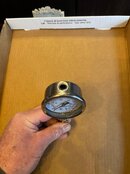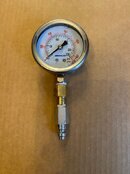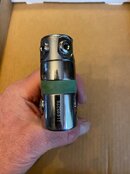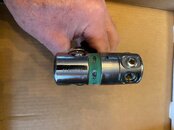You are correct.
Absolute Intermediate Pressure rises on descent as increasing ambient pressure assists the piston head in staying away from the valve, allowing more time for tank pressure to escape into the IP chamber.
And, as we all know from OW, relative IP remains constant as the increasing absolute IP is offset by increasing ambient with depth, leaving the same 124 psi at all depths.
The question is, what does the gauge see? If your gauge is like this HP gauge, or a more typical IP gauge with a sealed chamber and some gears...
View attachment 832968
...then as pressure in the inlet increases, the stakes chamber or this coil expands, and the needle moves higher. With higher absolute IP, that might seem to indicate you can then measure absolute, and prove that part of the equation. But using a gauge with leaks or holes, ambient pressure now transmits a counterforce to IP, and that counterforce increases with depth. Therefore, an IP gauge with holes is a relative IP gauge and with a normal system, will remain constant at all reasonable depths.
What was proved in post #21 above, is that a tight-fitting bicycle tire SPEC boot is an elastic roof over the ambient chamber. However, unlike the original SPEC boot with a thin, collapsible roof and a groove full of grease that can move in and out with breathing, we have a thick rubbery roof that resists deformation.
View attachment 832969
The dive with the tight fitting boot using the flooded IP gauge showed that instead of relative IP remaining constant during descent, relative IP actually
decreased. What was happening was that the tight-fitting boot (with an ambient chamber at 1atm at the surface)
sealed off the ambient holes (hence my silly reference to cheap garage regulators). As I descended, instead of a proper SPEC boot with a flexible roof collapsing slightly, and transmitting that pressure to the piston head, it deformed just a little, but not enough to keep up with the change from 1 to 2 atmospheres at 33feet. With the ambient chamber now lagging compared to ambient pressure,
absolute IP isn't rising as fast as ambient, and the Intermediate Pressure showing on the gauge dropped from 126 to 115. Then, when I left the pony on the bottom while I dived, and came back later the IP was up to 126. Why? because that tight fitting seal wasn't absolute, and water had leaked into the ambient chamber and equalized.
The whole point of the exercise was to show that while a perfectly lube-filled chamber with that relatively inflexible roof might indeed respond to the tiny piston movements with breathing, pressurization of the reg causes an initial much larger piston movement, which would squeeze grease out of the boot. Then depressurization after the dive would allow a little air in during storage. Then during the next dive, that pocket would act much like my completely air-filled test dive, and allow corrosion seawater into the ambient chamber, trapped by the tight boot.
In contrast, the clunky Inner Tube SPEC boot which has lasted 10 years (and we'll find out whether water got into the ambient chamber soon), was that same thick rubber, but this time over the entire groove, where there was much more room for flexing, and a reservoir of grease underneath.
View attachment 832972
Having that flexible roof and a reservoir is the simple reason this boot worked so well for 10 years, even down to Cozumel's occasional 130 ft depths. We'll see soon whether the ambient chamber is now filled with a 10-year-old mix of lube, seawater &, corrosion, or whether it has indeed stood a ten year test of time.
Keep in mind that this regulator was not immune to verdigris corrosion, and unsealed areas (e.g., the yoke bolt threads) needed annual cleaning as salt water had been driven down the threads by several atmospheres of seawater pressure. Soaking post-dive at 1 atm pressure does little to help diffuse out the salt, and annual disassembly is a good idea, no matter what mfrs tell you about 3-year service intervals.
The problem is the shift from the old Mk5's collared yoke bolt o-ring, which protected the bolt threads, to the now-typical end seal. At the cost of thread corrosion, this design offers the benefit of decreased extrusion risk. A bad design choice IMO.
View attachment 832974
View attachment 832973







